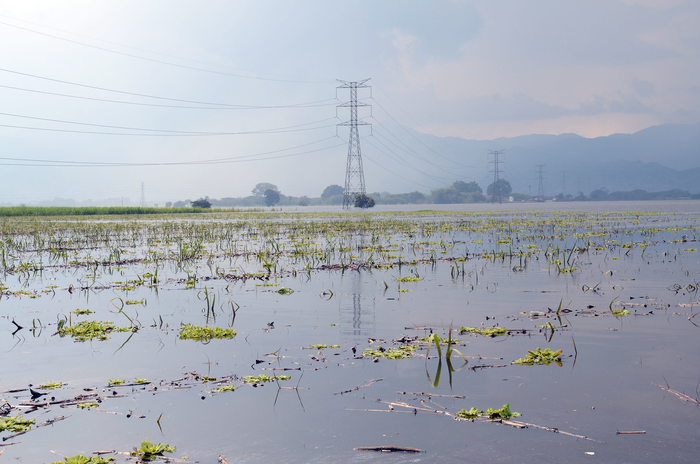One of the findings of the IPCC report, known as the Climate Change 2022: Impact, Adaptation and Vulnerability report, is that enhanced design and delivery are required to level up the climate services, implying decision making is supported by the climate data. This has been reported by Dr. Ana María Loboguerrero Rodríguez, the research director of climate action at the Alliance of Bioversity International and International Center for Tropical Agriculture (CIAT).
 With climate change, erratic weather conditions will increase, such as floods in these sugar cane fields near Cali, Colombia. Image Credit: Neil Palmer.
With climate change, erratic weather conditions will increase, such as floods in these sugar cane fields near Cali, Colombia. Image Credit: Neil Palmer.
The climate services are a part of the report, which was co-authored by Loboguerrero, which discovered that in a few high- and medium-income countries, climate services have been underutilized. In low-income countries, climate services have the potential to increase yields and incomes, thereby encouraging changes in the practices of farmers.
We have been saying for years that there has been a gap between climate information and concrete outcomes. It's not only about delivering the information in a timely manner, but how you communicate it and the translation of the information.
Dr. Ana María Loboguerrero Rodríguez, Research Director, Climate Action, Alliance of Bioversity International
A few instances of plans to boost the effectiveness of climate services involve combining data obtained from various sources at different scales, participatory collection and analysis of climate information, and making forecast data available in local languages or as verbal communication for farmers who lack the ability to read.
Scientists need to communicate better with the users of climate information, it is often hard to understand what the climatologists are saying. It's not just enough to produce the numbers, it's about the communication of this information and the use of this information with a clear objective so it can become a true climate service.
Dr. Ana María Loboguerrero Rodríguez, Research Director, Climate Action, Alliance of Bioversity International
It is very important to get this communication right, because a study performed over the past 10 years has discovered that farmers in the developing world are among some of the most vulnerable to changes in climate, from an economic viewpoint. Developing any tools that could help these farmers adapt to a changing world could possibly help to mitigate this blow.
Climate Committees
Involving farmers in the process could be one of the best ways in which climate information can be communicated in a better way. Also, connecting this data with the execution of climate-smart agriculture (CSA) is a method that concentrates on food security and climate change adaptation and mitigation.
One of the projects that Loboguerrero has supervised at the Alliance has been the development of Local Technical Agro-climatic Committees (LTACs). This has been established in local communities that allow farmers to make decisions depending on the knowledge of how local weather will tend to harm their agricultural production.
Loboguerrero states this is the main example of the ways in which climate risk could be regulated in an effective manner. Also, to carry out effective actions to mitigate the climate threats in agricultural sectors, it is essential to boost conversations between the various climate stakeholders like technicians, scientists, the private sector, farmers and decision-makers.
We started in 2015 with two in Colombia, now we have more than 60 across Latin America. They are now in Colombia, Peru, Ecuador, Paraguay, Chile, Mexico, Honduras, Nicaragua, Guatemala, Panama and El Salvador.
Dr. Ana María Loboguerrero Rodríguez, Research Director, Climate Action, Alliance of Bioversity International